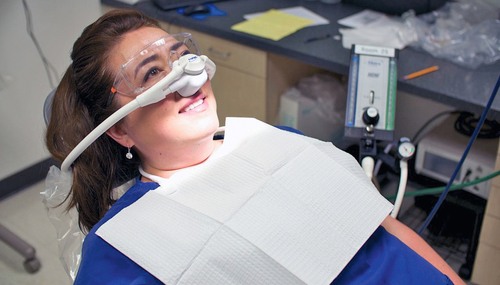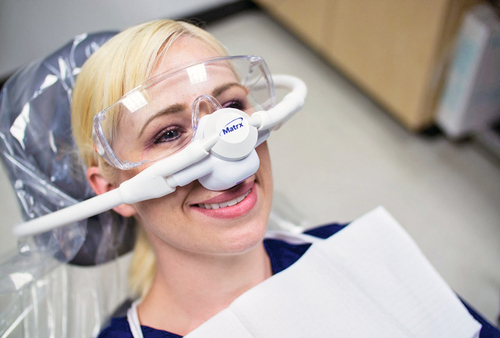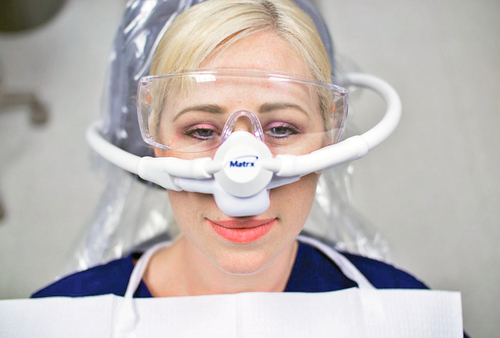Signs and Symptoms of N2O/ O2 Sedation
CHAPTER OBJECTIVES
Upon completion of this chapter, the reader should be able to:
1. Recognize the signs and symptoms of appropriate minimal sedation using nitrous oxide and oxygen.
2. Recognize the signs and symptoms of oversedation using nitrous oxide and oxygen.
Individual biovariability accounts for different reactions to various amounts of N2O. Some individuals experience several symptoms; others experience only a few. Symptoms are intense for some and insignificant for others. In some instances, signs are obvious; other times, signs are subtle. It is extremely important that the clinician is aware of the signs and symptoms that may be expressed when N2O/O2 sedation is administered and monitored. Keeping a constant vigil is imperative, because pleasant sensations may quickly become unpleasant. Knowledge of the appropriate technique and associated physical, physiologic, and psychological changes increases the practitioner’s confidence with the procedure and minimizes negative patient experiences. The ultimate goal is to increase patient comfort through relaxation.
1 Appropriate Minimal Sedation
A. A desirable level of sedation for both patient and operator using N2O/O2 sedation can be achieved by the use of the titration-time technique plus careful monitoring of the patient’s signs and symptoms. Certain physical, physiologic, and psychological effects may manifest in individuals when N2O and O2 are administered (Box 12-1).
B. It is imperative that the operator recognize when the desired effects are reached, because this point indicates that an appropriate level of sedation is accomplished, and administration of additional drug is not necessary. The operator must watch closely for the following:
1. Psychological signs
a. The patient is relaxed and comfortable (Figure 12-1).
b. If asked, the patient acknowledges a reduced sense of fear and anxiety.
c. The patient’s mood may be categorized as happy, pleasant, satisfied, or even ambivalent (Figure 12-2).
2. Body movement
a. Relaxation may be expressed overtly or inadvertently through physical movements. Signs of relaxation may include shoulders dropping, legs uncrossing, and arms positioned looser on arm rests.
b. Patients usually take deeper respirations when they are relaxed. A deep sigh or large inhalation may signal the patient is relaxing.
3. Eyes
a. The activity of the patient’s eyes is a good indicator of the level of sedation. With experience, the operator will often be able to make accurate judgments about the level of sedation by looking at the patient’s eyes.
b. Initially, during preparatory steps, patients’ eyes will be active. Patients will be alert, and their eyes will follow the operator’s actions and movements. This purposeful activity may lessen with sedation, because patients are no longer focused on the activities of others.
c. As sedation begins, the activity of the patient’s eyes will begin to slow. Eye movement will be reduced, and blink rate will be slower (Figure 12-3). Although not recommended, patients may indicate their eyes are heavy and want to close them.
d. As sedation continues, there will be a point, often, when the eyes may appear “glazed” or “glassy.”
4. Facial expression
a. Patients who are appropriately sedated are content. There is more of a “flat” expression rather than one that is “alert.”
b. There should be no signs of tension on the patient’s face. The patient’s forehead is a good place to look for tension and subsequent relaxation. When a patient is relaxed, muscles in the forehead and brow area should not be tight or strained.
c. Patients will also smile easily. Smiles may come during questioning about how they are feeling or patients will smile without conversation. The smile correlates with a happy, joyful mood. Patients may also “giggle a little.” They may say they “just can’t help but smile” followed by a short, slight laugh.
5. Awareness
a. When appropriately sedated, patients are fully conscious and aware of their surroundings. With relaxation, patients’ surroundings are no longer threatening, and patients will have a sense of well-being.
b. Patients will be able to respond rationally and coherently to the operator’s inquiry or directions. They can maintain conversation. With N2O/O2 sedation, protective cough and gag reflexes remain intact. It is important to stress that patients refrain from talking to receive the drug’s effects and minimize contamination of the environment.
c. If a local anesthetic injection is given during the procedure, the operator can test the patient’s level of sedation by asking, “Would this be a good time to give you the injection?” Patients will affirm the injection can be given when they are appropriately sedated and will be accepting of the procedure. Anecdotally, the success of this questioning has proven />
Stay updated, free dental videos. Join our Telegram channel

VIDEdental - Online dental courses





